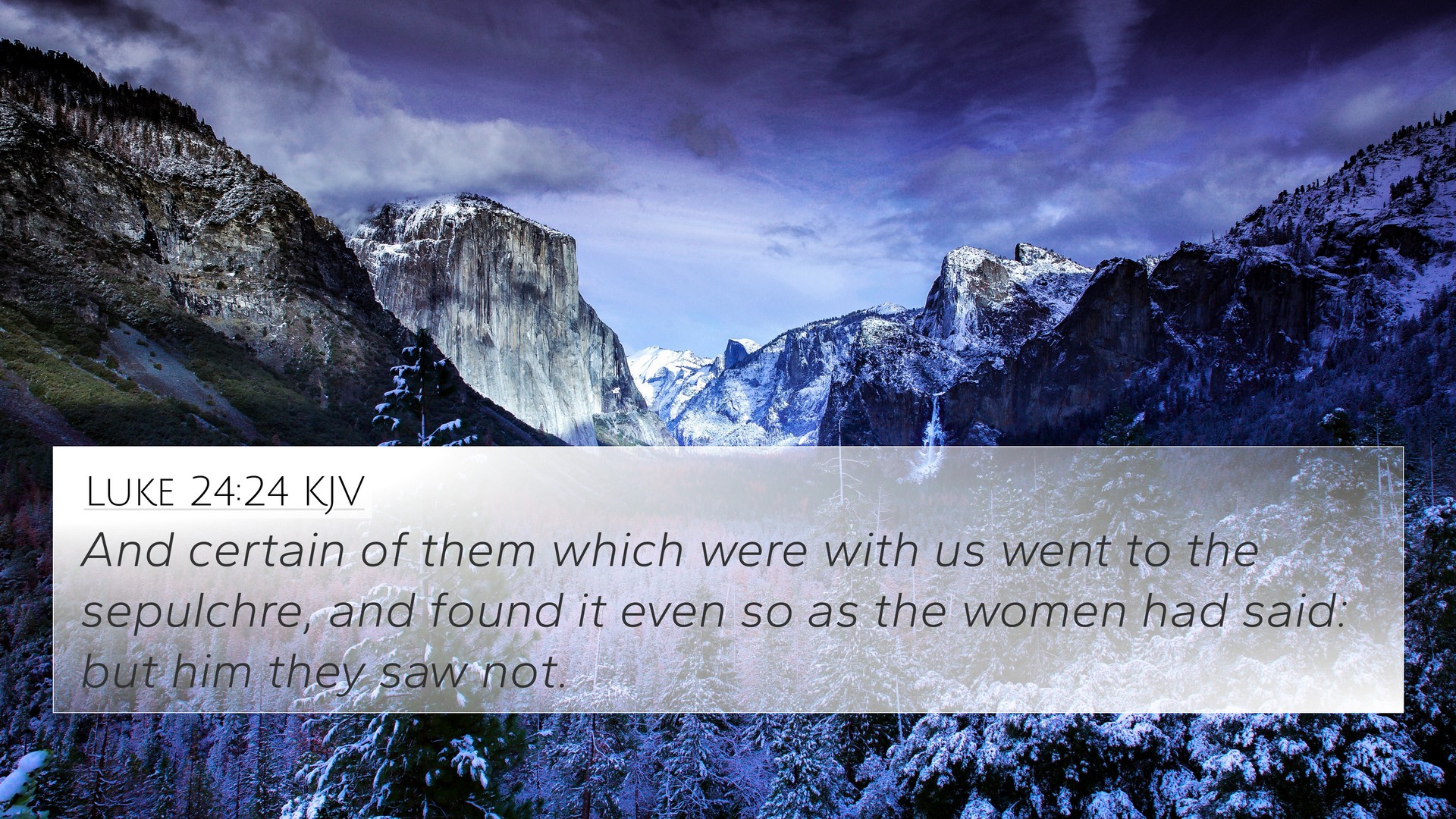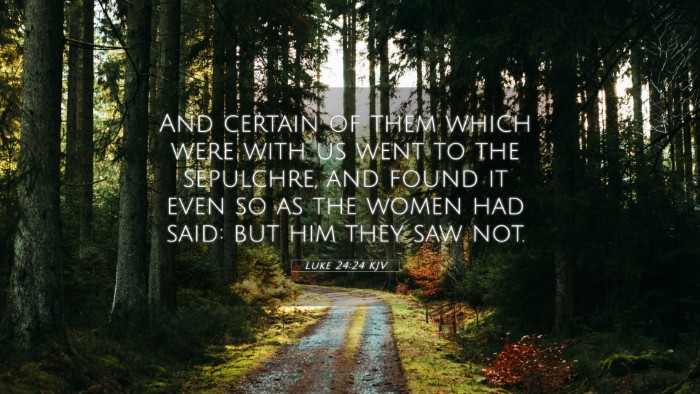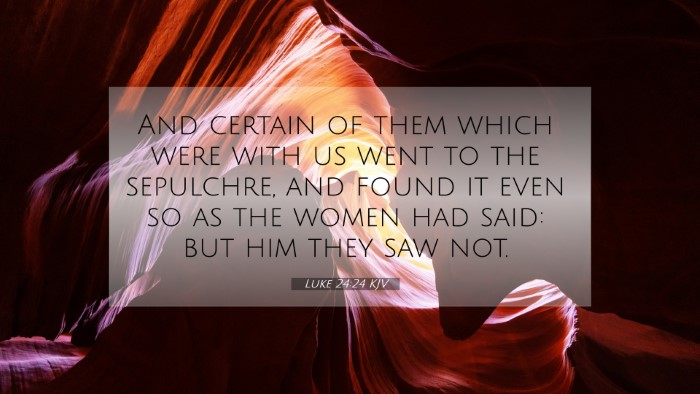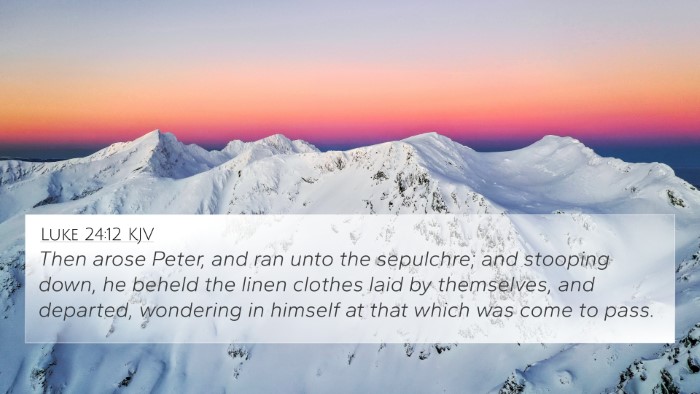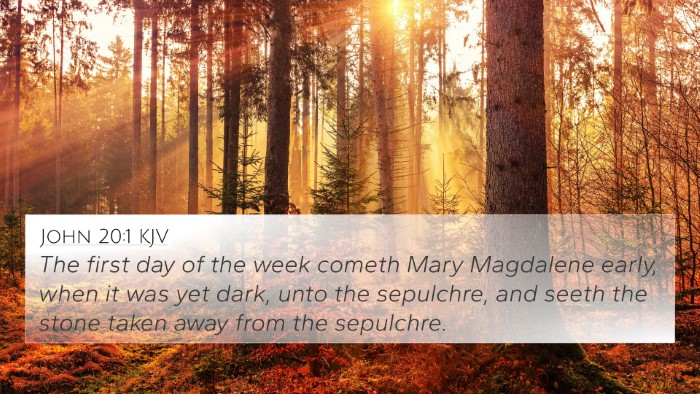Understanding Luke 24:24
Luke 24:24 states: "And certain of them which were with us went to the sepulchre, and found it even so as the women had said: but him they saw not."
This verse recounts a moment after the Resurrection of Jesus, where some of His followers traveled to the tomb to verify the women's reports of His resurrection. The verse highlights the initial disbelief among the disciples, despite the testimony from those who encountered the empty tomb.
Summary of Commentary Insights
Insights from renowned public domain commentaries provide a deeper understanding of this verse:
-
Matthew Henry:
Henry emphasizes the confusion and uncertainty faced by the disciples after the resurrection. The women, having encountered the empty tomb and angelic beings, brought a message of hope, yet the men's skepticism represents a common human response to miraculous events. This highlights the theme of faith versus doubt in the resurrection narrative.
-
Albert Barnes:
Barnes discusses the importance of the eyewitness accounts. He points out that the testimony of the women serves as a pivotal moment in the gospel narrative, indicating the critical role of women in early Christianity. This testimony was initially met with disbelief, illustrating the struggle of the disciples to comprehend and accept the reality of Jesus' resurrection.
-
Adam Clarke:
Clarke notes the implications of the disciples' visit to the tomb. Their actions show both curiosity and skepticism. Clarke discusses the broader significance of the resurrection and how it fulfilled Jesus' prophecies about His death and resurrection, urging readers to reflect on the importance of belief in the resurrection for the foundation of Christian faith.
Bible Verse Cross-References
Luke 24:24 connects to several other verses that enhance our understanding of its message:
- Matthew 28:6: The angel announces, "He is not here: for he is risen, as he said." This correspondence highlights the fulfillment of Jesus' words about His resurrection.
- Mark 16:10: Mary Magdalene reports the resurrection to the disciples, reinforcing the role of women in sharing the Gospel.
- John 20:10-18: Mary Magdalene encounters the risen Lord, showing personal testimony about the resurrection, as related to the disciples' disbelief.
- 1 Corinthians 15:14: Paul emphasizes the importance of the resurrection, stating, "And if Christ be not risen, then is our preaching vain, and your faith is also vain."
- Acts 2:32: Peter proclaims the resurrection boldly, connecting the events of the resurrection with the apostolic preaching.
- Romans 10:9: This verse speaks to the necessity of belief in the resurrection for salvation, linking to the idea conveyed in Luke 24:24.
- Hebrews 9:28: "So Christ was once offered to bear the sins of many; and unto them that look for him shall he appear the second time without sin unto salvation." This relates back to the faith of the disciples after they witness the resurrection.
- Matthew 16:21: Jesus foretells His suffering, death, and resurrection, which His followers find challenging to accept until the resurrection itself.
- John 14:29: Jesus reminds His disciples of His predictions about His death and resurrection, and then encourages them to believe when it comes to pass.
Thematic Connections Between Bible Verses
The connections between these verses and Luke 24:24 help illustrate key themes such as:
- Faith and Doubt: The struggle between belief and skepticism is a recurring theme in the New Testament, as highlighted in both the testimonies of the women and the disciples' initial unbelief.
- Role of Women: The involvement of women in proclaiming the resurrection is significant, indicating their crucial role in the early church.
- Fulfillment of Prophecy: Many verses emphasize Jesus’ predictions about His resurrection, aligning with the narrative of Luke 24.
- Importance of Witness: The emphasis on testimony, both by the women and later by the apostles, underlines the foundational aspect of eyewitness accounts in establishing the truth of the resurrection.
Applications for Bible Study
Understanding Luke 24:24 through the lens of cross-referencing can enhance one's study of scripture significantly:
- Tools for Bible Cross-Referencing: Utilize a Bible concordance or a Bible cross-reference guide to explore related verses.
- Comparative Bible Verse Analysis: Analyzing similar passages can deepen insight into the narrative and themes present in the resurrection accounts.
- How to Use Bible Cross-References: Look for connections not only within the Gospels but also across the New Testament and the Old Testament to see a broader theological framework.
- Identifying Cross-References: Resources that provide Bible chain references can guide you in discovering thematic links between scriptures.
Conclusion
Luke 24:24 serves as a pivotal moment illustrating both the disbelief and eventual understanding of the disciples concerning Jesus' resurrection. By engaging in cross-referencing and exploring connections between this verse and others, readers can gain a more profound understanding of the implications of the resurrection, encouraging a deeper faith and recognition of the miraculous nature of Jesus Christ’s victory over death.
